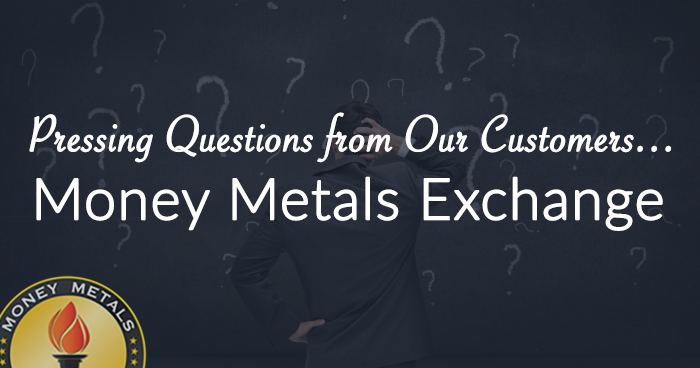Answered Here: Pressing Questions from Our Customers

At Money Metals Exchange, we believe a significant part of our mission is to educate customers and the public at large about the many aspects of the precious metals market.
While our precious metals specialists have the pleasure of addressing on an individual basis many excellent questions posed by our customers, we occasionally take the opportunity to address some of the best and most common questions in a more public way…
Budget-Conscious Financial Prepping When It Comes to Silver
Terry S. writes: You had a great article in the last issue [of Precious Metals Quarterly] on how to estimate the "true inflation-adjusted value" of an ounce of silver. That brings to mind a question that's been bugging me for a while, which might seem silly at first, but could become very important for budget-conscious "preppers" like myself: It is good to have a physical stash of silver if TSHTF, but if a single ounce will be worth so much, how will I buy smaller items?
Thanks for the kind words about the last issue. Right now among the public, complacency is high and inflation fears are low, as everyone seems convinced the Federal Reserve will be able to keep interest rates ultralow and do "QE" in perpetuity without causing any inflationary side effects. When inflation more noticeably heats up and the public starts seeking protection from it, silver will likely gain tremendous purchasing power – that is, increase in value in real, inflation-adjusted terms.
As I'm sure you know if you've been holding silver for any significant length of time, when silver moves, it doesn't move in baby steps! The more silver gains in purchasing power, the more you'll want to possess fractional-sized silver for bartering and trade – half-ouncers, U.S. 90% silver quarters and dimes minted before 1965, etc. You might even consider adding copper to your barter kit.
The metal value of a copper penny (minted from 1909-1982) is 2.4 cents. Currently circulating nickels are 75% copper/25% nickel and have an intrinsic value of 5.1 cents at current metal prices. Although it is currently a violation of government regulation to melt down nickels for their metal content, it is not illegal to hoard them! At some point, rising base metal prices will force the U.S. Mint to produce nickels out of cheaper metals such as zinc (which is what replaced copper in pennies after 1982).
Money Metals Exchange may consider offering one-ounce pure copper bullion rounds in the future. At present, however, seigniorage (the difference between the value of money and the cost to produce and distribute it) on copper products runs high. Minting costs, which represent a small portion of the cost of a one-ounce silver round, represent a huge portion of the cost of a copper round (an avoirdupois ounce of copper is worth only about 23 cents at current prices).
Great Question about the Weight of Junk Silver Coins
Stephen W. writes: Recently I purchased 50 pre-1965 dimes from a silver dealer. I noticed quite a variance in wear on the coins, so I took several to my pharmacist to have them weighed. The 1916 dime was the lightest, weighing 2.16 grams while the 1944 dime was the heaviest, weighing 2.49 grams. However, all quotes for prices on this coinage are listed per net dollar value rather than the actual weight of the silver. Should I be concerned when buying silver coinage and purchase it by weight only? Thanks for any insights you have.
Decades-old circulated silver coins will vary in terms of how much wear they show. It's not important when buying from or selling to a reputable dealer like Money Metals Exchange.
Dealers price junk silver as though every dollar of face value contains .715 troy ounces of silver. In reality, pristine coins have .7234 troy ounces of silver content. So there is already a small allowance for wear in the industry-wide weight/pricing standard.
Also, silver dimes and quarters tend to carry a lower premium vis-à-vis the silver spot market price than half dollars – this is likely the case because the wear tends to be greater on the dimes and quarters. So that is another way in which the issue of wear is factored in to the price you pay upon purchase or receive when selling.
Granted, if you try to barter with a silver dime, quarter, or half-dollar that looks extremely worn, the counterparty to a barter transaction might reject it or want to value it based on its weight rather than its denomination.
That's one reason why it's a good idea to add fractional-size (i.e., half-ounce, tenth-ounce) uncirculated silver rounds to your barter stash. They may be more convenient to use in some situations than pre-1965 coinage.

About the Author:
Clint Siegner is a Director at Money Metals Exchange, a precious metals dealer recently named "Best in the USA" by an independent global ratings group. A graduate of Linfield College in Oregon, Siegner puts his experience in business management along with his passion for personal liberty, limited government, and honest money into the development of Money Metals' brand and reach. This includes writing extensively on the bullion markets and their intersection with policy and world affairs.





